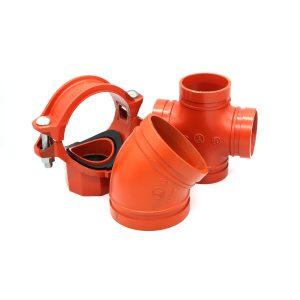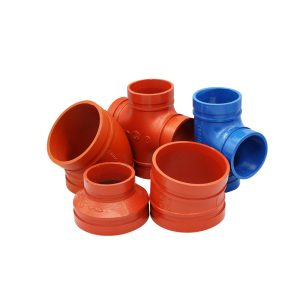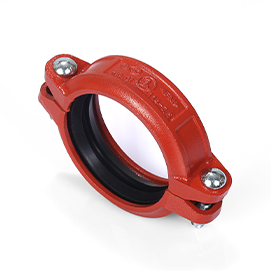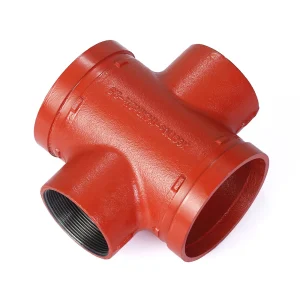
Hey there, if you’re knee-deep in piping systems for tough setups like fire sprinklers or industrial lines, you know picking the wrong flange can spell disaster. Leaks, failures, the works. I’ve been around the block with these things, and let me tell you, getting it right isn’t just about specs on paper—it’s about what holds up when the pressure’s cranked. In this post, we’re diving into the five biggies you gotta weigh when hunting for a grooved flange that’ll handle high-pressure without breaking a sweat. We’ll keep it real with examples from the field, some hard numbers, and tips that come from folks who’ve installed more of these than they can count. Stick around; this could save you a headache down the line.
Why Grooved Flanges Matter in High-Pressure Setups
First off, let’s set the stage. Grooved flanges aren’t your everyday connectors. They’re built for spots where pipes need to join fast and stay tight under serious stress. Think about a high-rise building’s fire system—water blasting at hundreds of PSI, or a factory line pushing chemicals. One weak link, and boom, downtime or worse. These flanges adapt grooved pipes to flanged gear, like valves or pumps, without welding. Saves time, cuts costs. But in high-pressure worlds, not all are created equal. Miss a detail, and you’re looking at repairs that eat your budget. I’ve seen projects grind to a halt over flanges that couldn’t hack it. So, yeah, choosing smart is key.
Factor 1: Material Strength and Standards
Alright, let’s kick this off with the basics—what’s it made of? You can’t skimp here. Most solid grooved flanges use ductile iron, like ASTM A536 Grade 65-45-12. Why? It’s tough, resists corrosion, and bends a bit without snapping. In high-pressure apps, that flexibility absorbs shocks from surges or vibrations. Picture a petrochemical plant: pipes humming with fluid at 300 PSI. A brittle flange cracks, and you’ve got a spill. No thanks.
Look for ones meeting ISO6182 or AWWA C606 too. These standards mean it’s tested for real-world abuse. And don’t forget coatings—epoxy or galvanized to fight rust. I remember a job in a coastal refinery; salt air chewed through lesser stuff in months. Went with ASTM A395 Grade 65-45-15 instead—still going strong after years. Data-wise, these materials handle up to 363 PSI without flinching, per design specs. Check the certs; if it’s vague, walk away.
Subtle Differences in Grades
Not all ductile irons are twins. Grade 65-45-12 has that sweet spot of tensile strength (65,000 PSI min) and yield (45,000 PSI). For extreme pressure, 65-45-15 ups the elongation, meaning it stretches more before failing. Small tweak, big difference in longevity.
Factor 2: Pressure Ratings and Testing
Pressure’s the name of the game, right? High-pressure means anything over 200 PSI, but some systems hit 500 or more. Your flange needs a rating that matches or beats that. Take the 225 PSI models—great for standard HVAC or fire lines. But crank it up, and you want 363 PSI versions. These are hydro-tested way beyond, often to 1.5 times rated pressure.
Real talk: I’ve chatted with engineers who learned the hard way. Installed a 225 PSI flange in a 300 PSI loop—held for a bit, then gave out during a surge. Messy. Always factor in peaks, not just steady state. And hey, PN16 ratings? That’s about 232 PSI at room temp, but derate for heat. Charts show it drops as temps climb. Use a table like this to compare:
| Pressure Rating | Max PSI | Typical Use | Temp Derating Example |
| 225 PSI | 225 | HVAC, Fire Protection | Drops 10% at 150°F |
| 363 PSI | 363 | Industrial High-Pressure | Stable up to 180°F |
| PN16 | 232 | General Piping | Varies by material |
Bottom line: Match the rating to your system’s max, add a buffer. It’s not overkill; it’s smart.
Factor 3: Size Compatibility and Range
Size matters—a lot. Grooved flanges come in 2″ to 12″ (DN50 to DN300), but not every supplier covers the full spread. In high-pressure, mismatch means weak joints. Say you’re linking a 6″ grooved pipe to a flanged pump. Need exact fit for the groove depth and flange bolt pattern.
Compatibility with standards like ANSI or DIN helps too. I’ve been on sites where a flange almost fit but didn’t seal—tiny gap, big leak. Go for adapters that bolt right on without mods. And think expansion: systems grow, so scalable sizes prevent future swaps.
- Small sizes (2-4″): Common in building services, handle pressure fine but check flow restrictions.
- Mid-range (6-8″): Industrial sweet spot; ensure groove aligns perfectly.
- Large (10-12″): For heavy-duty; weight becomes an issue, so lighter ductile iron shines.
Pro tip: Measure twice. A quick caliper check saves hours.
Factor 4: Temperature Tolerance
Heat and cold wreck havoc. High-pressure lines often run hot—steam, hot water—or freeze in outdoor setups. Look for flanges rated -20°F to +180°F (-29°C to +82°C). Below that, materials brittle up; above, seals soften.
In a boiler room I visited, flanges hit 160°F daily. Ones without proper range warped. Stick to tested limits. And gaskets? EPDM for water, Viton for chemicals. They expand/contract with temp swings, keeping seals tight.
Sometimes folks overlook cycling—hot to cold repeatedly. That’s fatigue city. Choose flanges with proven cycles, like thousands without fail. Data from AWWA backs this: proper ones last 20+ years in varying temps.
A Quick Aside on Weather
Ever think about outdoor installs? UV and rain add wear. Coated flanges resist better, but yeah, sometimes you just gotta shelter ’em. Learned that in a Midwest winter project—ice buildup was no joke.
Factor 5: Installation Ease and Long-Term Durability
Last but huge: How easy is it to slap on? Grooved means no welding—bolt it, done. But in high-pressure, torque matters. Over-tighten, crack; under, leak. Good flanges come with clear guides, like torque specs (say, 30-40 ft-lbs for bolts).
Durability ties in—vibration resistance, corrosion fight. Split flanges (like PN16) allow tweaks without full dismantle. I’ve seen teams save days on retrofits. And maintenance? Easy access beats buried welds.
Think ROI: Upfront cost vs. lifespan. A solid flange might run more but pays off in uptime. Industry stats? Failure rates drop 50% with grooved over traditional in pressure apps. Worth it.
- Quick install: 2-3x faster than flanged welds.
- Fewer tools: Just wrenches, no torches.
- Reliability: Less human error.
Wrap your head around that for big projects.
Introducing Vicast: Your Go-To Grooved Flange Supplier
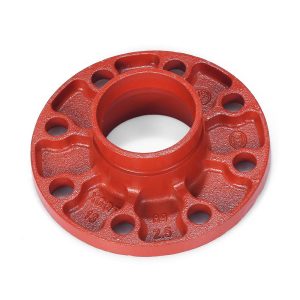
Speaking of reliable options, let’s shine a light on Vicast. These guys have been cranking out top-notch grooved fittings for years, focusing on stuff that stands up in demanding spots. From their adaptor flanges (like the XGQT13 series) to split designs, they cover the bases with that ductile iron build and strict standards. Based out of China but shipping global, Vicast emphasizes quality control—think full testing and certs. Their lineup hits those high-pressure needs spot-on, with sizes from 2″ up and ratings that don’t quit. If you’re scouting suppliers, check ’em out; they’ve got the track record.
Conclusion
Wrapping this up, nailing the right grooved flange for high-pressure isn’t rocket science, but skimping on these five factors? That’s asking for trouble. Material, pressure, size, temp, and install ease—they all lock together for a system that runs smooth and safe. Next time you’re spec’ing, run through this list. It’ll keep things flowing, cut risks, and yeah, save some cash long-term. Smart choices pay off.
FAQs
What are the top 5 critical factors for selecting the right grooved flange in high-pressure applications?
Well, it boils down to material strength (like ASTM grades), pressure ratings (225 vs. 363 PSI), size fit (2-12″ range), temperature handling (-20°F to 180°F), and how easy it is to install and maintain. Each one’s key to avoiding flops.
How does temperature affect choosing a grooved flange for high-pressure setups?
Heat or cold can make or break it. Flanges rated -20°F to +180°F hold up, but push beyond, and seals fail or materials crack. Always check your system’s range—I’ve seen hot lines warp cheaper ones quick.
Why is pressure rating so important when selecting the right grooved flange for high-pressure applications?
Simple: Mismatch it, and boom—leaks or bursts. Go for 363 PSI if your system’s aggressive; it’s tested to handle surges without sweat. Better safe than sorry.
Can size compatibility issues ruin a high-pressure grooved flange install?
Absolutely. Wrong size means poor seals, especially in 6-12″ pipes. Measure grooves and bolts exact—saves headaches later.
Where can I find reliable suppliers for grooved flanges suited to high-pressure?
Look at folks like Vicast—they’ve got the specs and quality. Shop around, but prioritize certs and real-user feedback.

